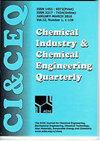方形复合电极电解微加工铜的性能研究
IF 0.8
4区 工程技术
Q4 CHEMISTRY, APPLIED
Chemical Industry & Chemical Engineering Quarterly
Pub Date : 2021-01-01
DOI:10.2298/ciceq210501036a
引用次数: 0
摘要
微型元件在航空、电力电路板、喷墨喷嘴和生物医学等行业的应用日益增多。在各种非传统的微加工方法中,电化学微加工(EMM)具有刀具无磨损、无残余应力、加工精度高等独特特点。本研究采用EMM方法研究方形不锈钢(SS)和铝金属基复合材料(AMC)刀具对方孔生成的影响。考虑了加工电压、占空比和不同浓度硝酸钠(NaNO3)电解液等重要工艺参数。从加工速率(MR)和超切量(OC)两方面评价了EMM工艺的性能。在8V、85%和23 g/l的参数组合下,AMC工具的OC值比SS工具低43.22%。对于相同的参数组合,SS工具的MR比AMC工具高71.6%。场发射扫描电镜(FESEM)图像分析表明,复合电极生成的微方孔在方孔的周长上有微凹坑。利用能量色散x射线能谱(EDAX)分析验证了强化在AMC工具中的存在及其分布。本文章由计算机程序翻译,如有差异,请以英文原文为准。
Performance study of electrochemical micromachining using square composite electrode for copper
The use of micro components is increasing day by day in the industries such as aviation, power circuit boards, inkjet nozzle and biomedical. Among various non-traditional micromachining methods, electrochemical micromachining (EMM) shows unique characteristics such as no tool wear, no residual stress and high accuracy. In this research EMM is considered to study the effect of square shaped stainless steel (SS) and aluminum metal matrix composite (AMC) tool on square hole generation. The significant process parameters such as machining voltage, duty cycle and aqueous sodium nitrate (NaNO3) electrolyte of varying concentration is considered for the study. The performances of EMM process are evaluated in terms of machining rate (MR) and Overcut (OC). The AMC tool shows 43.22 % lesser OC than the SS tool at the parameter combinations of 8V, 85% and 23 g/l. Also, for the same parameter combination MR for SS tool is 71.6 % higher than the AMC tool. Field emission scanning electron microscope image (FESEM) analysis shows that the micro square hole generated using composite electrode shows micro-pits on the circumference of the square hole. The energy dispersive X-ray spectroscopy (EDAX) analysis is conducted to verify presence and distributions of reinforcement in AMC tool.
求助全文
通过发布文献求助,成功后即可免费获取论文全文。
去求助
来源期刊

Chemical Industry & Chemical Engineering Quarterly
CHEMISTRY, APPLIED-ENGINEERING, CHEMICAL
CiteScore
2.10
自引率
0.00%
发文量
24
审稿时长
3.3 months
期刊介绍:
The Journal invites contributions to the following two main areas:
• Applied Chemistry dealing with the application of basic chemical sciences to industry
• Chemical Engineering dealing with the chemical and biochemical conversion of raw materials into different products as well as the design and operation of plants and equipment.
The Journal welcomes contributions focused on:
Chemical and Biochemical Engineering [...]
Process Systems Engineering[...]
Environmental Chemical and Process Engineering[...]
Materials Synthesis and Processing[...]
Food and Bioproducts Processing[...]
Process Technology[...]
 求助内容:
求助内容: 应助结果提醒方式:
应助结果提醒方式:


